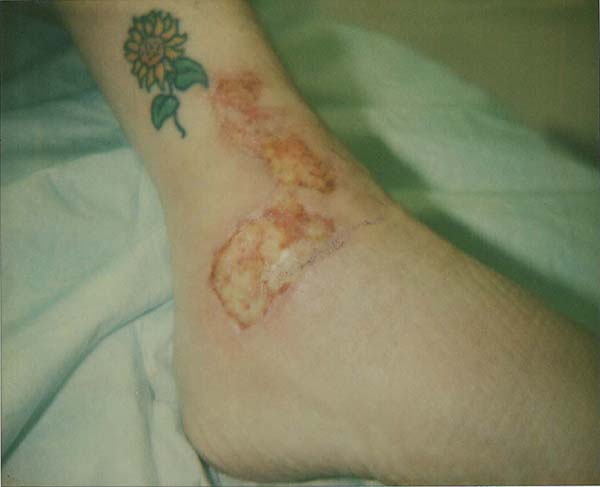On October 14, 2004, I woke up in the morning and started my day like any other. Sitting up in bed, I began pulling my pants off before I was going to transfer to my wheelchair and then go into the bathroom. As I pulled my pajama pants off, I suddenly felt a wetness on my right hand. My first thought was what many people with a spinal cord injury would probably think: that I had had an episode of incontinence sometime during the night. But the moisture was on the side of my right leg, not the seat of my pants. I removed my pants entirely to examine myself and was stunned by what I saw.
There were two enormous, puffy white blisters on the outside of my right ankle, about the size of my palm. It seemed there had been a third one, as well, but I had torn the top off of it when I pushed my pant leg down — the moisture I felt on my hand was the fluid from the burst blister. A wave of heat prickled over my body as the adrenaline hit me, my stomach turning and my heart starting to pound. My foot and ankle were swollen, pink, and hot to the touch. I woke my partner up and told him that we had to go to the emergency room immediately.
In those first panicked minutes I had no idea what it could be. Was my skin having a severe reaction to something like poison ivy? Did I get bitten by a poisonous spider? My mind finally settled on the obvious: it was a burn injury. The thing was, neither I nor my partner had any idea how it could have happened. The previous night we did go to a bar and had sat around a metal barrel that had a fire in it – but I had made darn sure that my feet and legs were protected. I had reached down and checked with my hand, often, that my feet and legs weren’t too close to the heat; every time an ember popped and I didn’t see where it landed, I checked my bottom half; there wasn’t even anyone smoking near me, so no errant cigarette could have landed on me. Besides, no ember or cigarette butt could have done the amount of damage my ankle had suffered. I was flummoxed.

In those first panicked minutes I had no idea what it could be. Was my skin having a severe reaction to something like poison ivy? Did I get bitten by a poisonous spider? My mind finally settled on the obvious: it was a burn injury.
Back when I first became paralyzed from a spinal cord injury, I and others like me had rehabilitation classes where we were taught how to take care of our bodies. These classes were numerous– Monday through Friday, at least three hours a day for two months. There was so much to learn about my new body. Keeping my bones strong; circulatory system changes; bladder and bowel maintenance; respiratory system issues; keeping my joints and tendons loose and flexible; and one of the most important things, how to take care of my skin.
When you have an SCI, the skin below the level of your injury, particularly if you have a complete injury (full paralysis, no movement), becomes akin to that of a baby’s: thin, soft, and delicate. The bottoms of my feet have no calluses because I do not walk on them; the skin on my legs is like velvet because they do not encounter friction from the fabric of my pants brushing against them. In addition to a decrease in friction, collagen is also decreased in the skin, as well as blood flow.
The delicacy of my skin means that I have to pay special attention to the care of it. I need to do pressure reliefs so I don’t get pressure sores over places where bones stick out. I need to make sure it doesn’t get too dry because dry skin is easily damaged. And I need to make sure that I am extra careful around things that are hot because my skin will burn much more easily than normal skin.
There were so many things to remember. When I completed rehab it was the year 2000 – there was no internet yet, at least not as we know it today. I left the hospital with a thick binder full of information about my new body. Even though I had this reference manual, I still had a lot of anxiety about going home. I felt like a newborn deer wobbling about on shaky legs, unsure of my next steps. What if I made a major mistake? What if I drove my chair off a curb, or passed out in the shower and fell over, or had an ingrown toenail form and didn’t catch it in time and it became infected and then I got sepsis? There seemed to be so many ways things could go wrong.
When I completed rehab it was the year 2000 – there was no internet yet, at least not as we know it today. I left the hospital with a thick binder full of information about my new body. Even though I had this reference manual, I still had a lot of anxiety about going home. I felt like a newborn deer wobbling about on shaky legs, unsure of my next steps.

After a couple of years and a few minor mishaps I began to regain some sense of confidence. Like many people with SCIs, it took me a little while to learn about my new body and its idiosyncrasies, tolerances, and abilities. I became more comfortable using my chair, being among people, and doing things I used to do. Such as going to bars with my friends where I could sit around a barrel fire and have a few drinks.
It was somewhere between our house and the emergency room that I figured out how my ankle had been burned. Maybe it was being in the car that clued me in. I was wracking my brain, retracing all my steps from the previous night: Left the bar, got in the car, took off my shoes and socks because my feet were swollen from me being up all day, propped my feet up on the dash to try and get the swelling down…right next to the car heater vent. The heater vent, which was on full blast – because it was winter. My ankle was laying right next to it for the full fifteen minute ride home. I almost couldn’t believe that a car heater could do so much damage, but it was the only thing that made sense.
I was devastated. My body was my baby, something I was charged with being responsible for, and I had failed. How many times had they hammered into us in rehab that taking care of our skin was one of our top priorities, that our skin was one of the most vulnerable things about our new bodies? It had been all about “avoiding skin breakdown” and “maintaining skin integrity,” and here I was, roasting my skin away like a rack of ribs.
When I arrived at the emergency room I was ashamed and expected judgement. I received none. Still, when I didn’t have an exact answer – only a theory — to the question, “What happened?” I felt incredibly embarrassed. Not just because I didn’t know how I was burned, but because I had a body that could be burned so badly yet I couldn’t feel a thing. How could she not feel it?, I imagined them thinking. I knew this was irrational, but I couldn’t stop the feeling. Looking back, I think it came from a place of anxiety. One of my worst fears had been realized: I had sustained a serious injury, one that was going to take months to heal, and I wasn’t even aware of it while it was happening. I only found out about it because I had seen it. It felt like all of my vigilance up until that point had been for nothing.

One of my worst fears had been realized: I had sustained a serious injury, one that was going to take months to heal, and I wasn’t even aware of it while it was happening.
After the doctor examined my ankle, I got the official diagnosis: third degree burn. It went down the side of my ankle and bent toward my foot in a J-shape. When the blistered skin covering it fell away some days later, I could see that all the layers of skin under it had been burned away; the interior of the burn area showed the layer of seared fat that was exposed. To this day, the car heater theory is still the only explanation I have.
I was shaken by the strangeness of it all. I didn’t feel the burn happening; I didn’t feel it when the doctor lanced the blisters, or when he bandaged my ankle. I was put on minimal painkillers, but that was only to reduce stress on my body. When I went back to the hospital to have the wound debrided – the procedure during which the dead flesh is removed so new flesh can grow – I felt nothing. As the doctor was scrubbing my wound I was merely watching his actions, chatting with him, and asking him questions about what he was doing. Debridement is normally a very painful procedure; he commented on how odd it was to be doing it to someone who wasn’t being affected by it at all.
As the initial shock of discovery started to wear off, the road to healing began. Since the burn was on my ankle, I knew the road was going to be a long one. People with SCIs have compromised circulatory systems below the level of injury, which means wounds heal more slowly – and the further away from the heart the wound is, the longer it will take to heal. My wound was going to be open for months, and it was going to be mostly up to me to try and ward off infection during that time. Unfortunately, infection set in in a couple of weeks.
I was put on antibiotics. My whole lower leg and foot was red, swollen, and hot. The flesh around the rim of the burn was turning a purplish-grey color. I was going to college part-time at the time, and I only left the house to go to my classes, then I was back in bed with my foot propped up on pillows, trying to keep the swelling down. I tried to do range-of-motion exercises to keep fluids circulating when I remembered to, but I was depressed and anxious and often felt like I couldn’t get myself to do much of anything at all.
I’ve kept a personal journal for the past twenty years, and an entry from the time of the burn injury shows the state of mind I was in:
"My fears are these: that I might lose this semester’s worth of school. That I may have to be hospitalized, away from my family and friends. That this separation may freak me out. That this whole episode will depress me to the point of me falling back down into the pit of depression. That if I have to leave school, I won’t go back…I wish my body could forgive me."
Laurie Crosby - Journal Excerpt
I never did need to leave school; I also avoided hospitalization. I did, however, fall into depression. I felt guilty for letting my body become so severely injured. There was also something else, a deeper feeling that kept me up at night, pushed me down and held me under its boot, a fear I articulated in that same journal entry:
“I feel like my body is just being eaten away by life, piece by piece.”
Laurie Crosby - Journal Excerpt
Just four years earlier I had almost died in a car accident that left my mind ravaged by then-untreated PTSD and a body I could no longer feel half of; now flesh on my right leg had been roasted away, almost down to the bone.
I feel like my body is just being eaten away by life, piece by piece. Just four years earlier I had almost died in a car accident that left my mind ravaged by then-untreated PTSD and a body I could no longer feel half of; now flesh on my right leg had been roasted away, almost down to the bone.


WARNING: Graphic Image
It felt like I’d hardly had time to catch my breath between injuries. Four years may seem like plenty of time to get over something, but becoming spinal cord injured is one of the most devastating disability experiences there is. There’s a long grieving process, and everyone’s timeframe for doing so is different. For me, I’d hardly begun accepting myself as a person with a disability when along came the burn, disabling me even more. I felt like the real me was disappearing.
It took almost three months, but the ankle did eventually heal, without needing skin grafts, fortunately. If you’d like to see a picture of it about halfway healed, you can see it here. (Warning: graphic.) (Also, warning: it’s a digital camera picture of a Polaroid picture, so the quality is poor – hey, it was 2004.) In the picture the burn has healed across the middle; when it was fresh it was one whole area, and significantly larger. As you can see, I just missed searing my tattoo off.
Looking back, I see the burn as a kind of rite of passage that many people with SCIs go through. For others it may not be a burn but a broken bone that introduces them to the reality of how vulnerable their bodies have become. I’ve had other injuries since then (a couple leg fractures), but nothing compares to the shock and anxiety of that first major post-SCI injury. It’s a unique reality those of us with SCIs live in, having to fend for our own body parts that can no longer fend for themselves. It’s like a weird sci-fi universe where we have to care for a helpless infant, and every bruise and cut the infant suffers also appears on our own body; every sickness it suffers, we suffer, too. It is always attached and never grows up — but it does grow old and becomes even more vulnerable as it does so.
Sometime between when the burn occurred and today, I forgave myself for what happened. To be honest, I didn’t really know I had forgiven myself until I was halfway through writing this article. I reflected on the injury and realized I didn’t feel as much guilt about it anymore, or anger towards myself. At some point in the past decade or so I began to be easier on myself about my mistakes, particularly honest mistakes — such as not knowing that something as simple as a car heater could cause third-degree burns. I’m still afraid of ways my body could become hurt that I might not be aware of until it’s too late, but if something did happen, I have more confidence now in how I could handle it, both practically and emotionally. It’s a hard-won confidence, and I’m glad for it because I may need to use it again sometime in the future.

Sometime between when the burn occurred and today I forgave myself for what happened. To be honest, I didn’t really know that I had until I had begun writing this article. I reflected on it and realized I didn’t feel as much guilt about it anymore, or anger towards myself.

